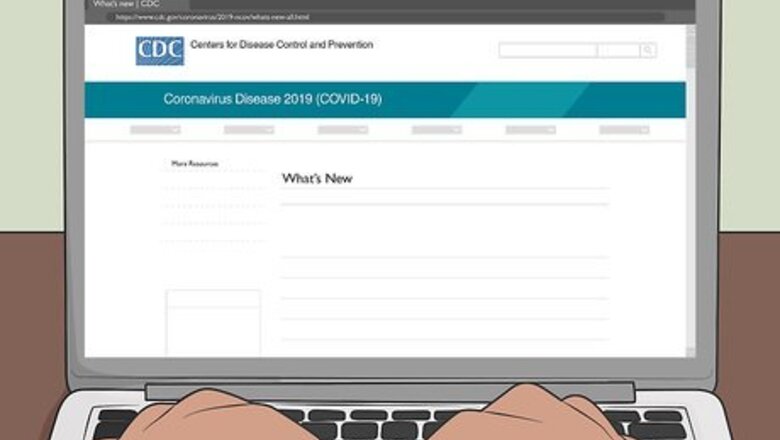
views
Looking up New Information
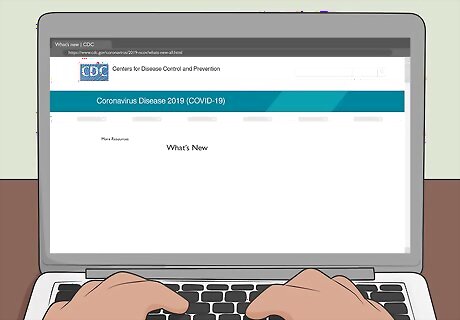
Check your local government’s COVID-19 web page. Your local leaders and health officials are the best sources for coronavirus updates in your area. Many city and state governments have online resources dedicated to novel coronavirus updates. Visit your local government’s website and search for the latest information about COVID-19 cases, testing, face-covering mandates, and lockdown measures. If you’re in the US, visit the CDC coronavirus update page for national updates at: https://www.cdc.gov/coronavirus/2019-ncov/whats-new-all.html. Check the websites of both your city and state governments for updates.

Visit the WHO coronavirus page for global updates. Use the WHO for official updates on the novel coronavirus pandemic. Go to their web page dedicated to COVID-19 and search for the most recent information on a variety of topics such as the latest information on research efforts, lockdown measures in different countries, recovery rates, and other guidance for the public. To go to the coronavirus page on the WHO website, visit: https://www.who.int/emergencies/diseases/novel-coronavirus-2019. Explore the WHO website for strategies and suggestions about avoiding exposure to COVID-19 as well.

Read the daily WHO situation reports for hard numbers and data. In addition to the regularly updated information on their website, the WHO also puts out a daily update called “Situation Reports.” Check out the latest report to find the most current data and figures related to the COVID-19 pandemic. To find links to the latest situation reports, visit: https://www.who.int/emergencies/diseases/novel-coronavirus-2019/situation-reports.

Search for updates from news organizations that cite credible sources. Use reputable news sources such as The New York Times, Washington Post, BBC, or another news organization with a history of trustworthiness. Search for updates on COVID-19 and check for references to legitimate sources such as the WHO, CDC, or UN Foundation so you know it’s reliable. Your local news outlets are good sources for updates about your area. Avoid news sites that look dubious. If you’re not sure if the site is biased or not, look it up at: https://mediabiasfactcheck.com/. Look for external links to reputable sources like the WHO or UN Foundation that verify or back up claims in the article. Keep an eye out for dubious sources. If a source is making a claim, but no other news organizations are reporting it, it could be false. Sign up for the UN’s Verified campaign (https://shareverified.com/en) to learn how to better spot accurate information about the COVID-19 pandemic.

Stay away from sources that offer cures for COVID-19. Avoid sites and sources that offer a product or a solution that claims to cure, test, or prevent COVID-19. There is no miracle cure for COVID-19, so any source that says otherwise isn’t trustworthy or reliable for updated information. By the same token, avoid sources that downplay the pandemic or refer to it as a “hoax.” Stop the spread of rumors and stay up to date with the facts about COVID-19 by visiting: https://www.cdc.gov/coronavirus/2019-ncov/daily-life-coping/share-facts.html or https://www.who.int/emergencies/diseases/novel-coronavirus-2019/advice-for-public/myth-busters.
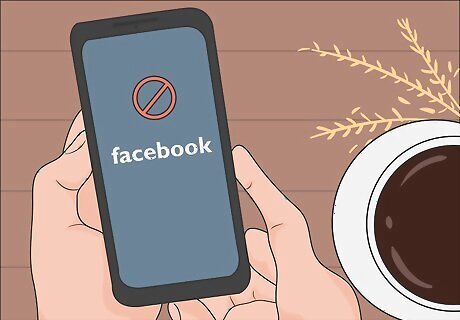
Avoid using social media for updates. Whenever you’re looking up new information about the coronavirus pandemic, stick to reliable news sources such as WHO, CDC, the UN Foundation, or your local health department. Avoid getting your updates about the pandemic from posts, memes, or opinions from people on social media, which may contain false claims or inaccurate information. Instead, use social media to connect with people and find some positivity. Social media can be a great way to boost your mood, especially if you’re stuck at home. You can still find accurate information on social media, just make sure it’s coming from a reputable source and isn’t a biased opinion. Use the UN’s Verified campaign to double-check sources.
Getting Regular Updates

Subscribe to a novel coronavirus newsletter for email updates. Go to the novel coronavirus page of a reputable source such as The New York Times, Washington Post, or governmental or multilateral organizations such as the CDC or WHO. Sign up for their COVID-19 newsletter to receive regular email updates directly to your inbox. Read the newsletter for updates on the pandemic. Many COVID-19 newsletters will discuss national and global updates. Your local news station may also have a COVID-19 newsletter you can subscribe to for local updates. You can sign up for WHO’s update at: https://www.who.int/news-room/newsletters. If you’re in the US, you can sign up for regular email updates from the CDC at: https://tools.cdc.gov/campaignproxyservice/subscriptions.aspx?topic_id=USCDC_2067.

Sign up for text message updates to receive local updates. Your local health authorities are the best places to receive text message updates about the pandemic. Visit your local state or city government’s web page dedicated to coronavirus updates and look for information about signing up for automatic text message updates. Text the number listed from your phone to start receiving updates via text message. Many cities, such as New York or New Orleans, have text message updates that give testing locations, new case numbers, as well as updates on lockdown measures. If your city doesn’t have a text message update system, check your state government’s website to see if they do.
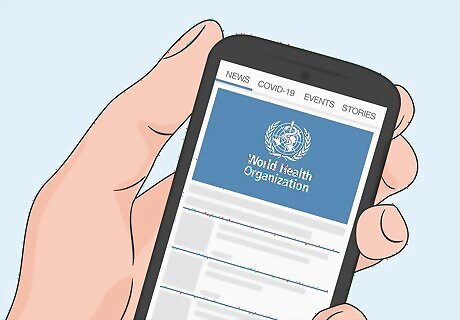
Download a news app to be alerted about updates. Many news apps provide COVID-19 updates and will send you push notifications whenever an update occurs. Download a news app to your smartphone or tablet and allow push notifications so you’ll be alerted whenever there’s an update. WHO has an information app called “WHO Info.” Search for it in your smartphone or tablet’s app store and download it to receive COVID-19 updates through the app. WHO also has information available via chatbots through Viber and WhatsApp. To learn more, visit: https://www.who.int/news-room/feature-stories/detail/who-health-alert-brings-covid-19-facts-to-billions-via-whatsapp. Check for a local news provider’s app so you can receive updates about your area. Choose a reputable news app, such as BBC or Google News, for national and international updates.

Watch news briefings about COVID-19 for new information. Whenever your local or national government leaders hold a press conference to give updates about the coronavirus, tune in to find out the latest information. If you can’t watch or listen to the live conference, look it up online to watch or listen to it whenever you get a chance. Press conferences are often the best way to get the most up to date information about new cases. Look up scheduled press conferences online so you can find out when they are.
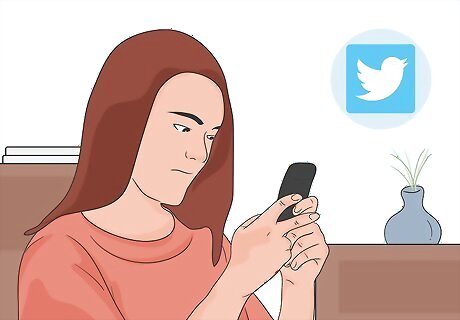
Follow the WHO and UN Foundation Twitter pages for updates. Both the WHO and the UN Foundation have Twitter accounts that regularly share articles and information related to COVID-19. Visit their pages and follow their accounts to be notified whenever they post a new article or press conference so you’re up to date with the most accurate information. Follow the WHO Twitter page at: https://twitter.com/who. Find and follow the UN Foundation Twitter at: https://twitter.com/unfoundation. If you’re in the US, follow the CDC Twitter for national updates by going to https://twitter.com/CDCemergency. You’ll need to have a Twitter account in order to follow their pages. If you don’t have an account, you can easily make one in about 5 minutes.
Taking Care of Your Mental Health

Mix in positive news stories to break up COVID-19 updates. Check-in on friends and family to see what’s going on with them for a bit of good news to break up the cycle. Look up positive news stories online for a refreshing break that will boost your mood and restore your faith in humanity. It’s helpful to be reminded that there’s still plenty of good people and happy things happening out there. For instance, you could reach out to that friend you haven’t seen in a while, or look up pictures of your cousin’s new baby on social media and comment about how cute they are.

Develop a routine to help you cope with everything going on. Use a daily routine to help give yourself a sense of control. Plan out your meals and any chores or tasks you want to get done. Write down or make a list of your schedule so it’s easy to follow. If you live with your family or other people, assign duties, such as cooking and cleaning, to different people so everyone has a task to accomplish. Try to wake up and go to bed around the same time each day to develop a consistent routine. If you’re working remotely at home, try getting dressed for work. Wearing the same clothes or pajamas all day can make your days seem longer. Being stuck at home, or even working from home, can make your days seem strange and endless. A schedule is a good way to restore a sense of order.

Stay physically active to stay healthy and strong. Try to exercise for at least a few minutes each day, even if it’s light work or some stretching, to keep your body strong. Eat a well-balanced diet that gives you all of the nutrition you need to stay healthy both physically and mentally. It’s important to take care of your body so you’re better able to resist or fight off the coronavirus if you’re exposed to it. Regular exercise will help reduce your blood pressure and lower your stress as well. To learn more about how to stay healthy during this time, visit WHO’s Healthy at Home resources: https://www.who.int/campaigns/connecting-the-world-to-combat-coronavirus/healthyathome.

Avoid using drugs or alcohol to deal with boredom or anxiety. Try to limit the amount of alcohol you drink to deal with your boredom, social isolation, or anxiety related to COVID-19. Avoid using drugs as well, which can have a whole host of negative health effects, which isn’t something you want while there’s a pandemic. It can be totally fine to have a virtual happy hour or a few drinks to help pass the time. But avoid having more than 3-4 drinks in a 12-hour period. Alcohol or drug use can cause you to stop taking healthy precautions against contracting COVID-19, such as hand washing or avoiding contact with others.
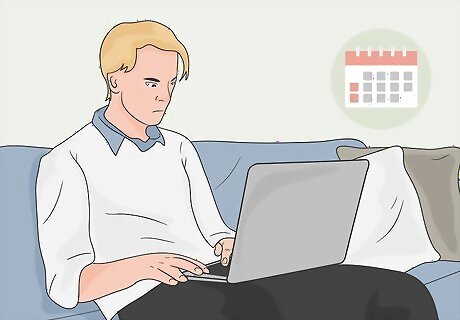
Check for COVID-19 updates only 1-2 times a day. Avoid checking for updates on the pandemic as soon as you wake up or multiple times a day so you don’t get anxious or feel overwhelmed. Set a specific time of the day to check in on the current status so you can stay up to date, but not feel extra stressed out about it. For example, you could choose to check for updates around lunchtime each day. With the constant deluge of news about the novel coronavirus, it’s easy to feel stressed or depressed if you’re always looking at the news.













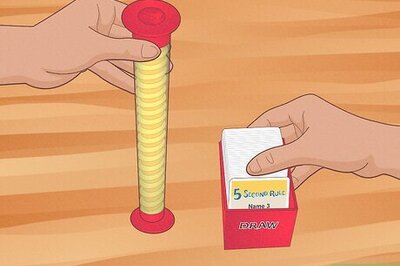

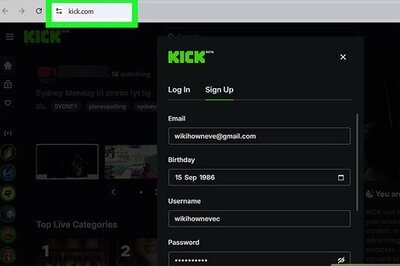
Comments
0 comment